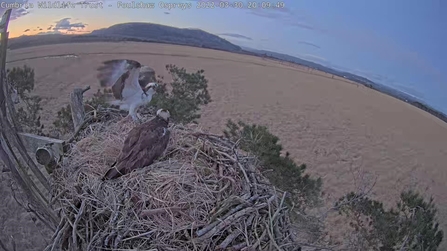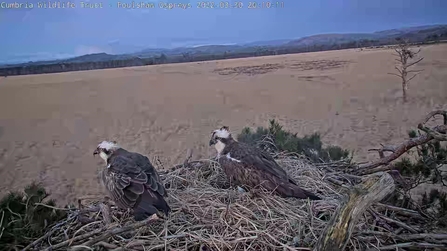
Foulshaw Ospreys return for the 10th time

Blue 35 is the first osprey back
Female osprey Blue 35 and her partner White YW first nested here in 2013, although they didn’t have chicks for the first time until 2014. Since then they have raised 21 chicks, some of whom have returned to Cumbria to have chicks of their own – Foulshaw grandchicks!
Blue 35 was the first one back, arriving just after 1 o’clock on Wednesday the 30th of March. She had probably travelled about 2,500 miles from the sun of west Africa or Portugal to be greeted by a howling wind and, just to rub it in, a brief snow flurry.
She was spotted landing on the nest on the webcam and managed to tease us by hiding her leg ring for a while, just to keep us guessing. Then she revealed her ID as she rolled up her sleeves to do some serious work on the nest. Dropping onto her front, she started digging a hole with her feet, a bit like a terrier trying to unearth a rabbit. The plan here is to create a nice little hole in the middle of the nest for the eggs to sit in.
When she had finished the DIY she started to look around and then began calling loudly for her mate in the hope that he would also have returned from his epic journey. After a while she got fed up waiting and flew off.
White YW's arrival
Around tea time there was another arrival on the nest. This time it was a male, also playing hide the leg ring. Eventually he too revealed who he was. It was Mr YW, back from his travels. He soon put his back into some nest work too, having a really good old dig with his tail in the air. His mate then returned to the nest and it was wonderful to see them reunited after six months apart.
The female osprey makes her autumn migration almost a month before the male, so they don’t travel together. As far as we know, they don’t have any contact while in their wintering grounds. Despite that, they still manage to arrive back at the reserve on the same day, driven by an urge to reclaim their nest before another Osprey tries to pinch it.
The nest fettling work is a big part of re-establishing their territory, but they also need to re-establish the bond between them. In younger pairs of birds, this can involve some quite elaborate courtship including some elegant sky dancing.
In more familiar pairs, like ours, they tend to bring it down to the basics - the basics being fish. She will spend almost six weeks on the eggs then a similar amount of time brooding the chicks. While she does that, she needs to be fed. The male must prove that he can put dinner on the table.
She checked his fishing reflexes by calling loudly, begging for food. He responded by heading off to find some fish. When he brought it to the nest, she grabbed it from him without much ceremony, then headed off to a tree to eat it.
Being about 15% bigger than him, she can call the shots in situations like this. But it doesn’t matter. He has proved he is still able to deliver the goods and provide for her as they start another season. Here’s to it being a good one.


